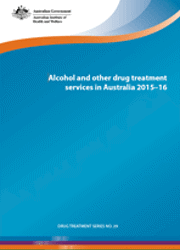Summary
Alcohol and other drug (AOD) treatment services across Australia provide a broad range of treatment services and support to people using drugs, and to their families and friends. This report presents information for 2015–16 about publicly funded AOD treatment service agencies, the people they treat, and the treatment provided.
1 in 180 people in Australia received treatment
An estimated 134,000 clients received treatment in 2015–16, an 11% rise since 2013–14 (119,000). This equates to a rate of 650 clients per 100,000 people, or about 1 in 180 people. About two-thirds of clients were male (67%), and half were aged 20–39 (55%). Despite only comprising 2.6% of the population, 1 in 7 (14%) clients were Aboriginal and Torres Strait Islander. This is a rate of 3,400 clients per 100,000 Indigenous Australians, compared with 540 clients per 100,000 non-Indigenous Australians.
Treatment agencies provided about 207,000 treatment episodes in 2015–16—an average of 1.5 episodes per client—and 4 in 5 (79%) episodes ended within 3 months. Of those clients who received treatment in 2015–16, 11% also received treatment in 2013–14 and 2014–15.
Treatment episodes for amphetamines rose by 175% over 5 years
Alcohol, cannabis, amphetamines, and heroin have remained the most common principal drugs of concern for clients since 2006–07. Nationally, alcohol was the most common principal drug of concern in 2015–16, accounting for 32% of episodes.
Between 2011–12 and 2015–16, the number of treatment episodes with amphetamines as the principal drug of concern increased by 175%, and cannabis treatment episodes increased by 40%, while heroin treatment episodes fell by 15%, and alcohol treatment episodes fell by 6%.
For clients aged 30 and over, alcohol was the most common principal drug of concern, while for clients aged 10–29, cannabis was the most common.
In the 5-year period, the proportion of episodes where alcohol was the most common principal drug of concern decreased from 46% to 32%, while the proportion of episodes for amphetamines more than doubled (from 11% to 23%). The number of episodes for clients injecting and smoking or inhaling amphetamines has also increased, with more than 4 times as many clients smoking or inhaling in 2015–16 as in 2011–12.
Almost half of clients received treatment for more than 1 drug
In almost half (45%) of treatment episodes, the client also reported additional drugs of concern. Nicotine and cannabis were the most common additional drugs of concern.
Counselling continues to be the most common type of treatment
Since 2006–07, the proportion of episodes for each main treatment type has remained fairly stable, with counselling, withdrawal management, and assessment only being the most common types of treatment. Counselling continues to be the most common main treatment type provided for clients (over one-third of episodes since 2006–07).
Preliminary pages: Acknowledgments; Abbreviations; Notes; Summary
-
Introduction
- Drug use in Australia
- National Drug Strategy
- Alcohol and other drug treatment services
- The AODTS NMDS
- Report structure
-
At a glance
- Agencies
- Clients
- Drugs of concern and treatment provided
-
Agencies
- Number of agencies
- Service sector
- Remoteness area
-
Drugs of concern
- Alcohol
- Cannabis
- Amphetamines
- Heroin
- Selected other drugs
-
Treatment provided
- Characteristics of clients and episodes
- Location of treatment
- Referral to treatment
- Duration of treatment
- Treatment completion
- Treatment types
Appendix A: Data and methods
Appendix B: Imputation methodology for alcohol and other drug treatment services clients
End matter: Glossary; References; List of tables; List of figures; List of boxes; Related publications; State and territory summaries



